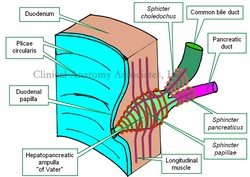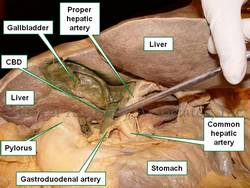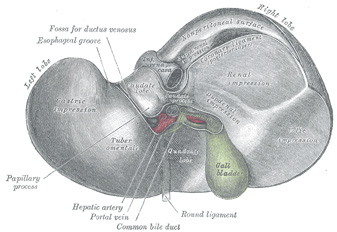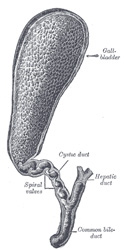
Medical Terminology Daily (MTD) is a blog sponsored by Clinical Anatomy Associates, Inc. as a service to the medical community. We post anatomical, medical or surgical terms, their meaning and usage, as well as biographical notes on anatomists, surgeons, and researchers through the ages. Be warned that some of the images used depict human anatomical specimens.
You are welcome to submit questions and suggestions using our "Contact Us" form. The information on this blog follows the terms on our "Privacy and Security Statement" and cannot be construed as medical guidance or instructions for treatment.
We have 1144 guests online

Georg Eduard Von Rindfleisch
(1836 – 1908)
German pathologist and histologist of Bavarian nobility ancestry. Rindfleisch studied medicine in Würzburg, Berlin, and Heidelberg, earning his MD in 1859 with the thesis “De Vasorum Genesi” (on the generation of vessels) under the tutelage of Rudolf Virchow (1821 - 1902). He then continued as a assistant to Virchow in a newly founded institute in Berlin. He then moved to Breslau in 1861 as an assistant to Rudolf Heidenhain (1834–1897), becoming a professor of pathological anatomy. In 1865 he became full professor in Bonn and in 1874 in Würzburg, where a new pathological institute was built according to his design (completed in 1878), where he worked until his retirement in 1906.
He was the first to describe the inflammatory background of multiple sclerosis in 1863, when he noted that demyelinated lesions have in their center small vessels that are surrounded by a leukocyte inflammatory infiltrate.
After extensive investigations, he suspected an infectious origin of tuberculosis - even before Robert Koch's detection of the tuberculosis bacillus in 1892. Rindfleisch 's special achievement is the description of the morphologically conspicuous macrophages in typhoid inflammation. His distinction between myocardial infarction and myocarditis in 1890 is also of lasting importance.
Associated eponyms
"Rindfleisch's folds": Usually a single semilunar fold of the serous surface of the pericardium around the origin of the aorta. Also known as the plica semilunaris aortæ.
"Rindfleisch's cells": Historical (and obsolete) name for eosinophilic leukocytes.
Personal note: G. Rindfleisch’s book “Traité D' Histologie Pathologique” 2nd edition (1873) is now part of my library. This book was translated from German to French by Dr. Frédéric Gross (1844-1927) , Associate Professor of the Medicine Faculty in Nancy, France. The book is dedicated to Dr. Theodore Billroth (1829-1894), an important surgeon whose pioneering work on subtotal gastrectomies paved the way for today’s robotic bariatric surgery. Dr. Miranda.
Sources:
1. "Stedmans Medical Eponyms" Forbis, P.; Bartolucci, SL; 1998 Williams and Wilkins
2. "Rindfleisch, Georg Eduard von (bayerischer Adel?)" Deutsche Biographie
3. "The pathology of multiple sclerosis and its evolution" Lassmann H. (1999) Philos Trans R Soc Lond B Biol Sci. 354 (1390): 1635–40.
4. “Traité D' Histologie Pathologique” G.E.
Rindfleisch 2nd Ed (1873) Ballieres et Fils. Paris, Translated by F Gross
"Clinical Anatomy Associates, Inc., and the contributors of "Medical Terminology Daily" wish to thank all individuals who donate their bodies and tissues for the advancement of education and research”.
Click here for more information
- Details
The [hepatopancreatic ampulla] or "ampulla of Vater" is a dilation found at the conjunction and common end of the common bile duct (ductus choledocus) and pancreatic duct (ductus pancreaticus). The presence of the hepatopancreatic ampulla creates a nipple-like elevation of the duodenal mucosa called the "duodenal papilla
The term [ampulla] is Latin and refers to a rounded and globular-shaped flask, which perfectly describes this structure. The hepatopancreatic ampulla was first described by Abraham Vater (1684 - 1751).
The hepatopancreatic ampulla is surrounded by a complex sphincteric mechanism, the "Sphincter of Oddi".
The ampulla of Vater is situated in the "choledochal window" an area of the duodenum devoid of musculature through which the hepatopancreatic ampulla / sphincter of Oddi complex passes. It is also complex in its interior. It usually presents an incomplete septum in its interior that separates the flow of pancreatic juice and bile at least for part of its trajectory.
In one of the known anatomical variations, this septum can be complete, having in fact a double-barreled ampulla that empties bile and pancreatic juice separately into the lumen of the second portion of the duodenum.
Image property of CAA. Inc. Artist: Dr. E. Miranda
- Details
UPDATED: The [common bile duct] also known as the [ductus choledocus]. is part of the hepatobiliary tree, taking bile from the gallbladder and liver to the second portion of the duodenum. The common bile duct begins at the junction of the common hepatic duct with the cystic duct, it continues inferiorly, usually to the right of the proper hepatic artery and anterior to the portal vein. It then passes posterior to the first portion of the duodenum, is surrounded by pancreatic tissue and ends at the hepatopancreatic ampulla of (Vater).
The junction of the common bile duct with the hepatopancreatic ampulla of (Vater) is the narrowest portion of the hepatobiliary tree, The lodging of a gallstone at this junction can be the cause for choledocholitiasis and jaundice.
In the accompanying image the common bile duct is elevated with a probe. The lesser omentum has been removed to show the common bile duct and vascular structures that are found between the two peritoneal layers that form the lesser omentum.
- Details
The [gallbladder] is a bile transient storage organ, part of the hepatobiliary tree, situated in the anteroinferior aspect of the liver. The gallbladder is found in a depression on the inferior aspect of the right lobe of the liver, the gallbladder fossa or fossa vesicae felleae.
In the gallbladder we describe its dome-shaped fundus, the body of the organ, and the neck which is the area that opens into the cystic duct. Close to the neck, the gallbladder has a small pouch (Hartmann's pouch) which is important for surgeons during a laparoscopic cholecystectomy, as this is where they will lock one of the instruments that allows them to manipulate the gallbladder for dissection of the organ from the gallbladder fossa (the gallbladder bed). The other surgical grasper is placed at the gallbladder fundus.
The gallbladder is composed by three layers. From deep to superficial they are:
• Mucosa: Characterized by a columnar epithelium. Towards the neck of the gallbladder the mucosa creates spiral ridges that continue in to the cystic duct.
• Fibromuscular layer: This layer is composed by connective tissue and smooth muscle, mostly longitudinal
• Serosa: This is an incomplete layer and is formed by visceral peritoneum covering the area of the gallbladder not in contact with the liver. In an unusual anatomical variation, the serosa layer can be almost complete, forming a pseudomesentery that may contains some veins.
The gallbladder receives its blood supply by way of the cystic artery, a branch of the right hepatic artery. The venous return is by way of multiple small veins that empty into the liver venous system. In some cases, these veins may form large sinuses between the liver and the gallbladder causing potential troublesome bleeding during a cholecystectomy. For those who like medical history, Dr. Eric Muhe performed the first laparoscopic cholecystectomy on September 12, 1985! We are but a few days from the 30th anniversary!
For more information on terminology on "gall-", "bile", "chol", and "chole", click here.
Sources:
1 "Tratado de Anatomia Humana" Testut et Latarjet 8 Ed. 1931 Salvat Editores, Spain
2. "Anatomy of the Human Body" Henry Gray 1918. Philadelphia: Lea & Febiger
Image modified by CAA, Inc. Original image courtesy of bartleby.com
- Details
Last Friday April 17, I prepared and delivered a lecture on "Surgical Sutures, Needles, and Knots" which included a hands-on workshop on knots and wound closure on simulated tissue.
This was presented at the invitation of the Pre-Health club of the Mount Saint Joseph University in Cincinnati, OH. I am always glad to be invited to do these presentations as they allow me to maintain contact with the future generation of Health Care Professionals.
Of course this is a very short presentation compared to the longer course that Clinical Anatomy Associates, Inc. delivers for medical companies, but it shows these future professionals the complexity of the world of wound closure, healing, surgical sutures, needles, and knots.
We ended the lab with the challenge to do a two-layer closure of a simulated wound. Most of the attendees did a pretty good job. Congratulations!
My personal thanks to Dr. Eric Johnson who coordinated the meeting, and to the Pre-Health Club for their invitation. For more pictures of the meeting, see the Facebook album page of "Medical Terminology Daily"
- Details
The cystic duct is a tubular structure that connects the neck of the gallbladder to the extrahepatic ductal system. It is 2-4 cm. in length and its lumen is about 2.6 +/- 0.7 mmm. The shape of the cystic duct varies, as it can be straight, angled, or acutely curved.
The mucosa of the cystic duct presents with 2-10 crescent-shaped folds that create a spiral-shaped inner structure referred to as the "Valve of Heister", first described by Lorenz Heister in 1732. These folds become smaller and scarcer towards the distal portion of the duct.
The cystic duct can present with several anatomical variations, from total absence where the neck of the gallbladder empties directly in to the common bile duct, to duplication, and even rare occasions where the cystic duct empties separately into the duodenal lumen.
The cystic duct is an important surgical landmark as it is one of the boundaries of the cystohepatic triangle or "Triangle of Calot", described by Jean-Francois Calot (1861 - 1944), which determines the location of the cystic artery, a critical structure that needs to be ligated and transected during a cholecystectomy.
Sources:
1 "Cystic Duct and Heister’s “Valves” Dasgupta,C, Stringer, MD, Clin Anat (2005) 18:81–87
2. "Tratado de Anatomia Humana" Testut et Latarjet 8 Ed. 1931 Salvat Editores, Spain
3. "Anatomy of the Human Body" Henry Gray 1918. Philadelphia: Lea & Febiger
Image modified by CAA, Inc. Original image courtesy of bartleby.com
- Details
The root term [-phor-] arises from the Greek word [φέρω] meaning “to bear”, “well”, and “healthy”. The meaning of the word today in medical terminology is “well-being”. The addition of the adjectival suffix [-ia] meaning “pertaining to” add to form [-phoria] meaning “pertaining to well-being” or “feeling well”. It is used in terms such as:
• Euphoria: The prefix [eu-] means “good”. The sensation of feeling good, of good well-being
• Dysphoria: The prefix [dys-] means “abnormal”. Abnormal feelings of well-being. In psychiatry these dysphoric moments can be seen in bipolar patients.






